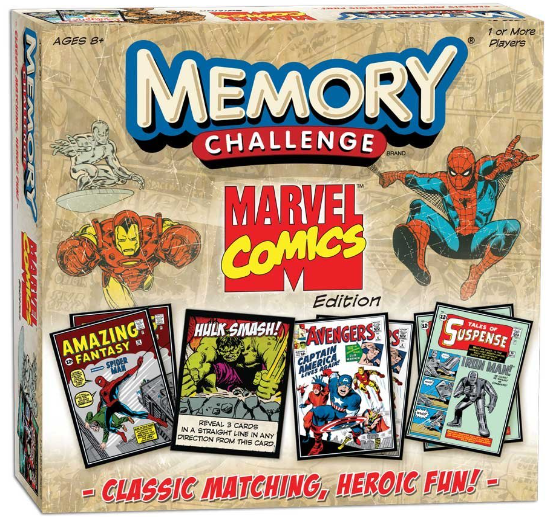Work on visual discrimination, visual memory, manual dexterity, turn taking, social interaction, play and leisure exploration and participation, spatial relations, eye-hand coordination, concentration
In the box: 100 comic book cards (50 sets), 10 power cards
Ages 8+, 1 or more players
A memory game with an added challenge (power cards) for comic book lovers. Each one of the cards is an actual comic book cover and most of them are from volume 1 of each publication or from other special editions, such as Spiderman gets married or Green Goblin's identity is revealed. There is a booklet that is included that pictures each cover and tells a couple of facts about it. Cards have very detailed graphics, are brightly colored, and fun to look at for even non-comic readers. Like memory games, turn all the cards face down and line them in rows on the table top. One hundred and ten cards makes a large grid. Turn over two cards at a time to try and find a match. If they match, take the cards and play again until you miss. Once you miss match, your turn is over and the next person plays. When all the cards have been matched, everyone counts their sets and the player with the most, wins. The power cards give special directions that you follow as soon as one is revealed. Special instructions include reveal four extra cards, end your turn immediately, and take a match from another player. The pictures are very detailed and after I looked at a few it was hard for me to remember what was where. The teens, however, didn't seem to have any trouble. I don't want to reveal my score the first time I played, but let's just say I barely avoided being skunked.
To read more about why memory games are so popular, read my post Memory Games. Why are They so Popular? This post also has links to the other memory games I have blogged about.
Try this:
- Turn several cards face up to start and leave them up until they are taken as part of a set. This will make a long game shorter and may help those who are not necessarily comic book fans make some sets.
- Prompt the individual to remember the card and its location, not just casually look at the card. Always turn the card back over in its present location to end a turn.
- Start with fewer sets and work your way up to 50. Fifty sets is a lot.
- Play alone to help develop concentration and memory skills. Count the number of plays it takes you to finish or time yourself. Play again and try to beat that number.
- Turn the cards over in place and don't pull them to the side of the table to assist in turning.




No comments:
Post a Comment
Thank you for taking the time to comment.